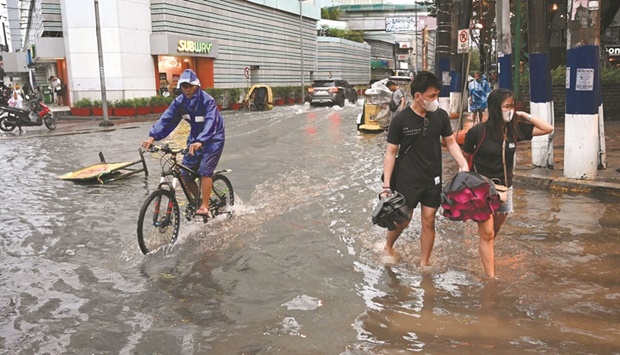Severe Tropical Storm Nalgae pounded the Philippines yesterday after unleashing flash floods and landslides that officials said left at least 45 people dead.
Nalgae churned across the archipelago nation’s main island of Luzon with winds of up to 95kph (59mph) after making landfall on the sparsely populated eastern island of Catanduanes before dawn.
It has sparked heavy rains across the country, with areas far from the path of the storm inundated, including the southern island of Mindanao, which has seen flooding and deadly landslides over the past two days.
A sharply revised official toll yesterday put the number of deaths on Mindanao at 40, with five others killed elsewhere in the country.
At least 17 people were missing, while nearly 20,000 had been evacuated.
In the Mindanao village of Kusiong, home to around 100 people, bulldozers and backhoes attempted to remove a thick layer of limestone rock and mud after parts of a nearby mountain collapsed on Friday.
Fourteen people have so far been pulled from the debris and more are still missing in the community.
“Had she died of illness it would have been less painful,” villager Mercedes Mocadef told AFP as she stood by three bodies, one of which turned out to be the daughter of her cousin.
The dead girl’s mother was also lost in the disaster.
Landslides and flash floods originating from largely deforested mountainsides have been among the deadliest hazards posed by typhoons in the Philippines in recent years.
“It could be more than a hundred,” Lester Sinsuat, mayor in the nearby town of Datu Odin Sinsuat, told AFP when queried how many people were feared dead.
Regional civil defence chief Naguib Sinarimbo said that “this is already a retrieval operation because the village (Kusiong) has been buried under rock and mud for more than a day”.
Philippine President Ferdinand Marcos Jr rebuked local civil defence officials in Mindanao over their preparations for the storm during a televised meeting yesterday.
“It will be important for us to look back and see why this happened. Why did we fail to evacuate them? Why do we have such a high casualty (figure)?” he said.
“We could have done better in Maguindanao in terms of preparing. The 40 deaths, with 10 people missing there is a little too high,” Marcos said.
He ordered the immediate distribution of drinking water and purifying systems to the province and other parts of the badly affected southern Philippines.
Marcos said that the aid response should be stepped up once Nalgae exits land areas this morning, according to the latest forecasts.
“Let us not wait for the helicopters and air assets to fly. If the weather is not good, look for more ways to deliver relief goods, water and medicines,” he said.
Mindanao is rarely hit by the 20 or so typhoons that strike the Philippines each year, but storms that do reach the region tend to be deadlier than in Luzon and central parts of the country.
The state weather service said the eye of Nalgae was expected to pass south of the capital Manila, a sprawling metropolis of more than 13mn people, in the early evening yesterday.
The flooding in the country’s capital region, which includes Manila and other cities, flooding prompted authorities to suspend classes and sports events.
Airlines have cancelled 116 domestic and international flights to and from the Philippines’ main gateway, which stopped operations from 0800-1400 GMT because of strong winds, the transport ministry said.
Nearly 7,500 passengers and workers, and 107 vessels, were stranded in the country’s ports, the coast guard said.
Manila Mayor Honey Lacuna-Pangan ordered the closure of the city’s cemeteries, where millions had been expected to visit during the extended All Saints’ Day weekend.
“If it’s not necessary or important, we should avoid going out today because it is dangerous,” said national civil defence director Rafaelito Alejandro, adding that 5,000 rescue teams were on standby.
Photos released by the Philippine coastguard showed rescuers using an old refrigerator as a boat to pull children from a flooded community on the central island of Leyte.
Storms kill hundreds of people in the Philippines yearly and keep vast regions in perpetual poverty, with residents also having to grapple with frequent earthquakes, volcanic eruptions, and in some areas armed insurgencies.
Scientists have warned that storms are becoming more powerful as the world gets warmer because of climate change.
In December, category 5 Typhoon Rai ravaged central provinces, leaving 407 dead and more than 1,100 injured.

A resident sits near debris from a landslide in the village of Kusiong in Datu Odin Sinsuat, southern Philippines.

People leave a beach following heavy rain brought by Tropical Storm Nalgae (Paeng) in Manila.

